The baby Betta are probably closer to 1cm than my initial estimate. I wasn't expecting territorial behaviour quite yet, but one has set up shop in an Anubias and it looks, to al intents and purposes, as though s/he is chasing the others away when they get close. I know a fair bit about dog behaviour (I'm a behaviourist lol) but I'm not so hot on fish. If I were to put the behaviour I'm seeing into the canine world, it would be akin to puppies playing in order to practise predatory/social behaviours for adulthood. Do fish do this?
-
You are viewing the forum as a Guest, please login (you can use your Facebook, Twitter, Google or Microsoft account to login) or register using this link: Log in or Sign Up
Journal An 'arium of some kind.
- Thread starter Myrtle
- Start date
Hi all,
Cheers Darrel
The males are homicidal to one another from a young age. That is one of the problems with breeding them, you need a lot of space to store the "spare" males in.The baby Betta are probably closer to 1cm than my initial estimate. I wasn't expecting territorial behaviour quite yet, but one has set up shop in an Anubias and it looks, to al intents and purposes, as though s/he is chasing the others away when they get close....
Cheers Darrel
That was part of the reason why I didn't intent to breed properly; I don't have the space for separation. I wasn't expecting it quite so soon though! I've got several sponge filters running ready to set up separate accommodation so I guess that'll be sooner rather than later!Hi all,
The males are homicidal to one another from a young age. That is one of the problems with breeding them, you need a lot of space to store the "spare" males in.
Cheers Darrel
Finally caught the last baby betta (not such a baby now!) for a final total of 6, at least 4 of which are males. The smallest isn't doing so good after being picked on by a larger one, but is hanging on still. I have some females coming soon whose parents are from Frank's Bettas lines, so only a few generations away from wild.
Plans are afoot for a new epiphyte log in the main tank. I had a cork tube left over from the initial build which I hadn't decided on a use for, but I've had a shift around and it's perfect spot popped up. I'm planning on documenting the creation if anyone is interested? I have the time as I'm signed off work for 4 weeks and it's pretty much the sum total of what I can do at the moment.
More general update coming soon!
Plans are afoot for a new epiphyte log in the main tank. I had a cork tube left over from the initial build which I hadn't decided on a use for, but I've had a shift around and it's perfect spot popped up. I'm planning on documenting the creation if anyone is interested? I have the time as I'm signed off work for 4 weeks and it's pretty much the sum total of what I can do at the moment.
More general update coming soon!
ScareCrow
Member
As I was reading I was thinking, I hope you document the process. So yes please from me.I'm planning on documenting the creation if anyone is interested?
It's the first time I've tried it and if it wasn't for other folk journaling their builds on other fora, I wouldn't know where to start lol!As I was reading I was thinking, I hope you document the process. So yes please from me.
Phase 1 started last night; bunging up one end with expanding foam. Don't zoom in too closely as the rug is in dire need of vacuuming!

This is where the tank's at now; the gap just left of centre is where the log is going. Because the branch in the middle will be holding some of the weight, I thought it best to anchor it a bit more. Cue even more expanding foam! Gratuitously included the Anubias Pangolino in the second shot.
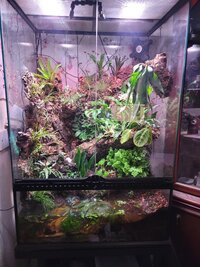

I'm still having issues with balancing the misting and ventilation, particularly now the heating is on and the relative humidity has dropped. I'm struggling to get enough moisture in the background for the mosses to get going properly. They're doing well, if slowly (I keep reminding myself that it is moss and it is winter) in the lower half where the cork is wicking the water from the "pond". The yellow cherry shrimp in there are all plugging along well, I don't think they will breed in this temperature (maxing out around 19C, pushing 20C if the sun comes out and dropping to 17C) so if they still don't want to breed by the end of summer, I'll pop a wee heater in to keep it around 22C.
I spotted this Platycerium in the bargain bin at Homebase for £2.95 last week so home it came. Removed it from its hanging basket and mounted it on some cork. I've only ever seen one other shop selling them (excluding online) so was quite pleased.

The open fronted drip wall is also having issues (besides the ever present fungus gnats), again it's an issue with keeping the moisture at the right level. This time it's mechanical failure, or rather a failure on my part to foresee the issue with algae growing in the tubing and blocking the drip nozzles, that's to blame. I feel like I spend half my life adjusting the nozzles! A redesign is in order, but I'm not sure which way to go yet. Irrigation seep hose may be my next move but I've yet to find out if that comes in different diameters. Failing that, I might jut go with a single length of hose and melt hole sin it like a spray bar...
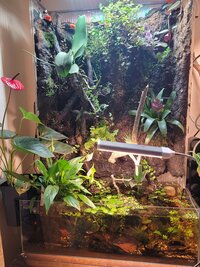
The tank itself is doing quite nicely, by no means an aquascape and certainly not a biotope, but I think it replicates the imbellis habitat quite nicely so hopefully the new girls will feel at home. I'm slowly training the Hydrocotyle leucocephala from the tank and up the wall to soften the transition a bit. This should work well if I can get the moisture level stable. Even with some periods of drying out more than I'd like, the mosses and liverworts are beginning to take hold and bothe Crypts and the Buce are enjoying there positions. The Phaeleonopsis (from the bargain bin at Homebase again) is putting on new growth since being put on the wall. The poor thing has endured being knocked out of its pot several times by one of the dogs as well as arriving with mealy bugs, but it goes to show how tolerant these hybrids are. There's a reason I keep plants this way and that is because I constantly forget to water them and they never survive!
To be honest, I pick them off and drop them in the fish tanks! Once the plants are stronger, they can cope with the odd bug. Because the water runs down to the tank I can't use any chemicals. This plant isn't fixed yet so I can also remove it to spray with a water jet and if absolutely necessary, remove it for chemical treatment, though I usually find that washing them off every few weeks eventually gets rid of them, especially when there's only a few to begin with.
Phase 2 of the log build this afternoon. As usual, I've done everything a bit backwards and the plants have arrived before the rest of the sphagnum, but I made a start anyway with what little moss I had left over.
First I took the sphagnum and rehydrated it in some aquarium water as I like to recycle where I can. The nutrients in the water won't hurt either. I squeezed out all the excess water and started stuffing the damp moss into all the nooks, crannies and crevices (this tube has plenty!) as tightly as possible. To this end, a pair of curved nail scissors is very handy!


As with everything in my house, copious amounts of dog hair was also included. It was at this point that I realised I couldn't quite remember the position I had planned, so I fiddled around a bit until I was happy. It wasn't quite where I originally intended (I don't think so, anyway) but whatever! This will be intentionally removable as I still need to access the pump that is underneath it so if/when I remember the exact position I can move it, but it's as near as damn it now.
Now some green stuff and the point of the stuffed sphagnum becomes apparent. The damp sphagnum ensures that there's an easy surface to grab on to and enough moisture remains under the chopped live moss to enable it to take hold until established. I've just used some Christmas, Weeping and Java moss trimmings, chopped and mixed. These pieces aren't glued or tied, just poked on. Still loads left to go on. Really, this should be done after the next part but I did it this way.


The expanding foam bung isn't watertight as it naturally cured with a few gaps for drainage. If it hadn't, I'd have poked a few channels through it with a metal skewer. It's purpose is mainly to keep the internal stuffing of damp sphagnum from dropping out. This is just rehydrated moss as before, with excess water squeezed out. It's used to fill the inside of the tube to a) ensure a steady level of moisture, and b) give a free draining substrate for the epiphytes to hold on to. The very top section will be filled with a more compost based mix. However, I ran out of sphagnum as the new lot I ordered hasn't been delivered, so I popped it into the tank in time for the evening misting and there it shall stay until the next lot of moss arrives. Once it does, I'll update again.
First I took the sphagnum and rehydrated it in some aquarium water as I like to recycle where I can. The nutrients in the water won't hurt either. I squeezed out all the excess water and started stuffing the damp moss into all the nooks, crannies and crevices (this tube has plenty!) as tightly as possible. To this end, a pair of curved nail scissors is very handy!


As with everything in my house, copious amounts of dog hair was also included. It was at this point that I realised I couldn't quite remember the position I had planned, so I fiddled around a bit until I was happy. It wasn't quite where I originally intended (I don't think so, anyway) but whatever! This will be intentionally removable as I still need to access the pump that is underneath it so if/when I remember the exact position I can move it, but it's as near as damn it now.
Now some green stuff and the point of the stuffed sphagnum becomes apparent. The damp sphagnum ensures that there's an easy surface to grab on to and enough moisture remains under the chopped live moss to enable it to take hold until established. I've just used some Christmas, Weeping and Java moss trimmings, chopped and mixed. These pieces aren't glued or tied, just poked on. Still loads left to go on. Really, this should be done after the next part but I did it this way.


The expanding foam bung isn't watertight as it naturally cured with a few gaps for drainage. If it hadn't, I'd have poked a few channels through it with a metal skewer. It's purpose is mainly to keep the internal stuffing of damp sphagnum from dropping out. This is just rehydrated moss as before, with excess water squeezed out. It's used to fill the inside of the tube to a) ensure a steady level of moisture, and b) give a free draining substrate for the epiphytes to hold on to. The very top section will be filled with a more compost based mix. However, I ran out of sphagnum as the new lot I ordered hasn't been delivered, so I popped it into the tank in time for the evening misting and there it shall stay until the next lot of moss arrives. Once it does, I'll update again.

The sphagnum arrived today. Here's a shot of how it arrives compared to after rehydration:

It only takes a few mins to absorb the water and of course I now have a shed load left so must find a new project for it! The top half of sphagnum was mixed with vermiculite to help with drainage and aeration and some was also added to the planting pocket at the bottom:


Then in went one of the Restrepia orchids which of course, I forgot to photograph.
The top section was filled with a loose mix of compost, orchid bark, vermiculite and sphagnum and more sphagnum holds it in place. This is where the Oncidium sits which should have a lovely trail of yellow flowers (assuming it doesn't abort the flower stem after the disturbance). Pinned to the side is Gomesa radicans. This is just sat on a small piece of sphagmun with another few strands over the roots and pinned in place with wire. The rest of the moss trimmings were put in place along with a small piece of Bolbitis heteroclita:
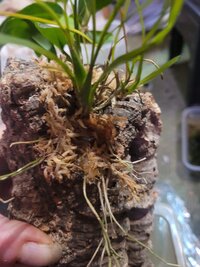


It would be better in a less vertical position, but I didn't have room. Still awaiting delivery of a few more plants and I may add some Buce to the lower section once I can see how wet it's going to be. And there you have it, simple to build and easy to maintain when you have automatic misting!

It only takes a few mins to absorb the water and of course I now have a shed load left so must find a new project for it! The top half of sphagnum was mixed with vermiculite to help with drainage and aeration and some was also added to the planting pocket at the bottom:


Then in went one of the Restrepia orchids which of course, I forgot to photograph.
The top section was filled with a loose mix of compost, orchid bark, vermiculite and sphagnum and more sphagnum holds it in place. This is where the Oncidium sits which should have a lovely trail of yellow flowers (assuming it doesn't abort the flower stem after the disturbance). Pinned to the side is Gomesa radicans. This is just sat on a small piece of sphagmun with another few strands over the roots and pinned in place with wire. The rest of the moss trimmings were put in place along with a small piece of Bolbitis heteroclita:



It would be better in a less vertical position, but I didn't have room. Still awaiting delivery of a few more plants and I may add some Buce to the lower section once I can see how wet it's going to be. And there you have it, simple to build and easy to maintain when you have automatic misting!
What a disaster of a weekend. Losing a fish is bad enough (one of my sparkling gourami) but on Saturday night one of my tanks developed a crack in the base due to using the mat that came with it for a different tank. Fish hastily moved to spare tank, majority of plants dumped in other tanks and new one ordered. They're only cheap nanos from Amazon so that'll be here soon. Could have done without discovering the leak at 3am though. The biggest problem though, and the reason for posting all this in this journal, is that of my female imbellis got stuck behind the support for the wall in the original practice 'arium. She was duly rescued but is the second fish to have been stuck there so the whole thing had to be removed permanently. The tank now looks very sad.

The plants have all been unceremoniously wedged into the exo-terra and all that's left is a few bits of cork. To be honest, it wasn't working well; the drip system kept getting clogged and the expanding foam background, whilst looking fine, didn't really give anywhere for the plants to root. Without the protection of the 3 sides of the background, I've had to temporarily shove a non-fitting lid on to stop the Betta jumping. It does give me the opportunity to totally redesign the set up though, hopefully in a way that works for emersed plants whilst keeping the imbellis from carpet surfing. Being a shallow tank, lowering the water level isn't as useful as it would be for a full sized tank so building up again is one option. The other option I considered was another exo-terra, but the unit it sits on isn't deep enough for the size I'd need and the next size down has a footprint too small for the group of Betta. So DIY again. Or buy a full sized tank and lower the water level... No decisions made yet.
I'm still

The plants have all been unceremoniously wedged into the exo-terra and all that's left is a few bits of cork. To be honest, it wasn't working well; the drip system kept getting clogged and the expanding foam background, whilst looking fine, didn't really give anywhere for the plants to root. Without the protection of the 3 sides of the background, I've had to temporarily shove a non-fitting lid on to stop the Betta jumping. It does give me the opportunity to totally redesign the set up though, hopefully in a way that works for emersed plants whilst keeping the imbellis from carpet surfing. Being a shallow tank, lowering the water level isn't as useful as it would be for a full sized tank so building up again is one option. The other option I considered was another exo-terra, but the unit it sits on isn't deep enough for the size I'd need and the next size down has a footprint too small for the group of Betta. So DIY again. Or buy a full sized tank and lower the water level... No decisions made yet.
I'm still
I decided to try to keep the redesign simple this time, I have a tendency to over complicate things and as this is more of an emergency rescape, simpler has to be better!
I decided to base it on a biotope but with artistic license for the time being. First job was to build up the rear and sides of the tank to prevent carpet surfing - I've not lost one yet to jumping but I have had to rescue 3 different betta after jumping during tank maintenance!

This was built with double wall polycarbonate, the same as the tank lids, as I happened to have a bit left over as well as the thicker piece that blew off my neighbour's gazebo last winter! The corners were silicone and while that cured overnight I grabbed some tape to hold a spare bit across the front. Unfortunately I'd run out of masking tape and only had hinging tape! Yeah, bad move. It doesn't come off. I'll deal with that later!
I was going to go for a riparium, using the roots to provide hiding places for the Betta but the raised sides made that too complicated, so with my new (probably short-lived) simplistic approach, I opted for paludarium but without a fully terrestrial area, so the full footprint can still be used by the fish. Being Betta, they relish shallow areas so the "land" portion will be under several inches of water, giving plenty of hiding spots for the females in the undergrowth.
To build the "land" I used insect mesh (annoyingly white) and sewed it into a rough basket with fishing line. The sides and back were reinforced with offcuts of double walled polycarbonate. Here it is being modelled by the cracked tank.

This was placed in the empty spot where the pup for the drip wall originally sat and filled with substrate from the tank that broke at the weekend. This currently has a Spathyphyllum and some Acorus from the filter of the Betta cube. In the post are Juncus repens and Cyperus helferi which will hopefully give more of a look of the edge of flooded land when grown emersed.
In front is a deeper marginal area with Lindernia rotundifolia and Hygrophila polysperma 'Rosanervig'. The rest of the tank is pretty much as it was previously.
To protect the front corners (prime jumping zones) the HOB filter occupies one corner and a cork raft covers the other. The eventual plan is to drill holes in the cork and plant through it so the roots suspended in the water will give more cover. This is how it looks as of tonight. Yeah, it looks rubbish right now but I have confidence that in a few months it'll start looking decent.

This time tomorrow I'm hoping the water will have settled and it'll look better for that.
More work to do on it tomorrow so another update coming then.
I decided to base it on a biotope but with artistic license for the time being. First job was to build up the rear and sides of the tank to prevent carpet surfing - I've not lost one yet to jumping but I have had to rescue 3 different betta after jumping during tank maintenance!

This was built with double wall polycarbonate, the same as the tank lids, as I happened to have a bit left over as well as the thicker piece that blew off my neighbour's gazebo last winter! The corners were silicone and while that cured overnight I grabbed some tape to hold a spare bit across the front. Unfortunately I'd run out of masking tape and only had hinging tape! Yeah, bad move. It doesn't come off. I'll deal with that later!
I was going to go for a riparium, using the roots to provide hiding places for the Betta but the raised sides made that too complicated, so with my new (probably short-lived) simplistic approach, I opted for paludarium but without a fully terrestrial area, so the full footprint can still be used by the fish. Being Betta, they relish shallow areas so the "land" portion will be under several inches of water, giving plenty of hiding spots for the females in the undergrowth.
To build the "land" I used insect mesh (annoyingly white) and sewed it into a rough basket with fishing line. The sides and back were reinforced with offcuts of double walled polycarbonate. Here it is being modelled by the cracked tank.

This was placed in the empty spot where the pup for the drip wall originally sat and filled with substrate from the tank that broke at the weekend. This currently has a Spathyphyllum and some Acorus from the filter of the Betta cube. In the post are Juncus repens and Cyperus helferi which will hopefully give more of a look of the edge of flooded land when grown emersed.
In front is a deeper marginal area with Lindernia rotundifolia and Hygrophila polysperma 'Rosanervig'. The rest of the tank is pretty much as it was previously.
To protect the front corners (prime jumping zones) the HOB filter occupies one corner and a cork raft covers the other. The eventual plan is to drill holes in the cork and plant through it so the roots suspended in the water will give more cover. This is how it looks as of tonight. Yeah, it looks rubbish right now but I have confidence that in a few months it'll start looking decent.

This time tomorrow I'm hoping the water will have settled and it'll look better for that.
More work to do on it tomorrow so another update coming then.
aec34
Member
Ooo I’m excited by this idea - when you’re buying cork is there anything to keep an eye out for? I’ve never played with it.The eventual plan is to drill holes in the cork and plant through it so the roots suspended in the water will give more cover.
I just used virgin cork bark, like they sell for reptiles. I've had a few floating pieces with H. tripartita growing on it. I like the bark because it's sustainable recyclable and looks good even before stuff has grown!Ooo I’m excited by this idea - when you’re buying cork is there anything to keep an eye out for? I’ve never played with it.
It's the much maligned Seachem Tidal 35 🙂 and yes, there's an Anthurium growing in it alongside a bit of sponge (synthetic, so obviously not growing!). Any excuse to squeeze another plant in!@Myrtle what filter is that you're using? it looks like you've got a plant growing out of it.
Progress has been made! I'd been struggling to come up with a suitable jumping Betta blocker for the front of the tank and thanks to @Tyko_N I made a plan.
I'd been toying with the idea of a raft such as used in ripariums but the premade ones aren't available here. I have an abundance of poly boxes lying around so ended up building one from part of a old box lid and some capillary matting. It's currently held in place with fishing line and suction cups but @Tyko_N to the rescue again with the idea of tying it to tank lid supports. Much better idea!
So, after a lot of poking around, this is how it's looking at present:
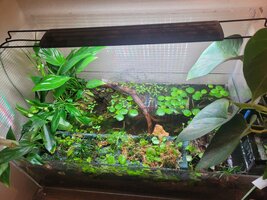
I pretty much just threw what moss I'd rescued from the paludarium wall onto it and nicked a bit from the exo-terra. I did put some sphagnum in some areas to see if it helps. I theorise the it'll create a bit more humidity in the air spaces than would be available on just the capillary matting, but that might be a load of bunkum! I made some planting holes in it and added a Spathyphyllum, some Mondo grass and a bit of Ceratopteris thalictroides to see how they would do. The rest is covered mainly in the abundance of Hydrocotyle vercilliata I had. Hopefully the straight edge will disappear soon under a sea of hydrocotyle. The main thing is that the Betta are now as safe as I can make them short of having a tight fitting lid.
Due to the lack of light the very front of the tank will now receive (other than some sunlight and ambient light) I've left that unplanted and will be building up wood/leaf litter there.
The rest of the plants for the raised area should arrive tomorrow so hopefully that will tie it together a bit more.
With the changes, the back of the tank now gets much more light than it did, so I may add something to the current Crypt heavy planting.

I'd been toying with the idea of a raft such as used in ripariums but the premade ones aren't available here. I have an abundance of poly boxes lying around so ended up building one from part of a old box lid and some capillary matting. It's currently held in place with fishing line and suction cups but @Tyko_N to the rescue again with the idea of tying it to tank lid supports. Much better idea!
So, after a lot of poking around, this is how it's looking at present:

I pretty much just threw what moss I'd rescued from the paludarium wall onto it and nicked a bit from the exo-terra. I did put some sphagnum in some areas to see if it helps. I theorise the it'll create a bit more humidity in the air spaces than would be available on just the capillary matting, but that might be a load of bunkum! I made some planting holes in it and added a Spathyphyllum, some Mondo grass and a bit of Ceratopteris thalictroides to see how they would do. The rest is covered mainly in the abundance of Hydrocotyle vercilliata I had. Hopefully the straight edge will disappear soon under a sea of hydrocotyle. The main thing is that the Betta are now as safe as I can make them short of having a tight fitting lid.
Due to the lack of light the very front of the tank will now receive (other than some sunlight and ambient light) I've left that unplanted and will be building up wood/leaf litter there.
The rest of the plants for the raised area should arrive tomorrow so hopefully that will tie it together a bit more.
With the changes, the back of the tank now gets much more light than it did, so I may add something to the current Crypt heavy planting.

Glad I could help, and that's going to look great once the plants has grown in a bit @Myrtle. You might want to watch that Spathiphyllum though, in my experience they tend to like those kinds of places a bit too much and grow huge (unless it's a dwarf cultivar), so it might destabilize your island. I have Cyperus alternifolius 'Zumula' instead, if you're looking for another tall and bushy plant. It likes the same wet conditions but stays smaller and more delicate, and can be pruned if needed.
Last edited:
I am now calling this complete (meaning I'm going to stop messing about with it and moving stuff pointlessly) and shall wait patiently (or not) for it to grow. It's about as far from a true biotope as you can get but most of it was planted with bits from other tanks or what was already there. The only plants I bought for it were the Cyperus helferi, Juncus repens and 3 pot luck damaged plants; one Echinodorus, one Hygrophila of some kind and another stem which is recovering in another tank.
The Cyperus and Juncus have created a nice marshland effect and as the water there is only 3 inches deep it's perfect for baby betta and betta girls to hide out. The rest is heavily planted with whatever I had to hand - mainly Hygrophila sp. which will hopefully grow out of the water.
I took your advice @Tyko_N and moved out the Spathyphilum and replaced it with Schismatoglottis prietoi. Now to see what lives and what dies!



I had to light this up to take the photo as I's really quite gloomy under there!

The Cyperus and Juncus have created a nice marshland effect and as the water there is only 3 inches deep it's perfect for baby betta and betta girls to hide out. The rest is heavily planted with whatever I had to hand - mainly Hygrophila sp. which will hopefully grow out of the water.
I took your advice @Tyko_N and moved out the Spathyphilum and replaced it with Schismatoglottis prietoi. Now to see what lives and what dies!



I had to light this up to take the photo as I's really quite gloomy under there!

Update time.
Things move slowly, growth-wise in low tech, but there's always something happening. The ex-arium now sports the moss log/filter contraption which suits it a bit better than the tidal 35. The raft at the front is growing in well, too well when it comes to the hydrocotyle! It also proved to be a big hit with the male imbellis in there, who has raised 2 nests of fry under it so far! I've had to move the females out temporarily as he was getting quite cross with them trying to eat his babies! Shine a torch in there after lights out and it's a fair sea of fry.
The Juncus repens failed (again) sio it was replaced with Eeleocharis sp. I've never been successful with Juncus repens so I'm giving up on it. The Cyperus helferi is still holdng on, though I'm not sure what it isn't liking. Perhaps it's confused as the air temperature is cooler than the water, which would be the other way around in nature (I think?). The acorus seems to be doing ok though and the crypt sea appears to be thriving, not that I can really see much of it! Anyway, here it is as of today, home to 1 male Betta imbellis and his army of fry:
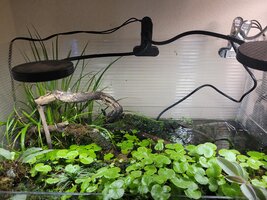
The exo-terra is slowly growing in. I lost a couple of orchids but others (restrepias and oncidium especially) and the small colony of yellow cherries is stable, though not reproducing yet. I'm hoping that it's due to the temperature and once we hit summer they'll have some shrimplets. I was a bit concerned that the water parameters would cause them moulting issues but so far, they've been moulting fine. Even though the misting unit sprays water with a tds of 0, I make sure I add some tap to the pond part during water changes.



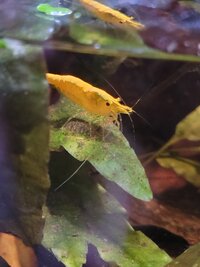
Things move slowly, growth-wise in low tech, but there's always something happening. The ex-arium now sports the moss log/filter contraption which suits it a bit better than the tidal 35. The raft at the front is growing in well, too well when it comes to the hydrocotyle! It also proved to be a big hit with the male imbellis in there, who has raised 2 nests of fry under it so far! I've had to move the females out temporarily as he was getting quite cross with them trying to eat his babies! Shine a torch in there after lights out and it's a fair sea of fry.
The Juncus repens failed (again) sio it was replaced with Eeleocharis sp. I've never been successful with Juncus repens so I'm giving up on it. The Cyperus helferi is still holdng on, though I'm not sure what it isn't liking. Perhaps it's confused as the air temperature is cooler than the water, which would be the other way around in nature (I think?). The acorus seems to be doing ok though and the crypt sea appears to be thriving, not that I can really see much of it! Anyway, here it is as of today, home to 1 male Betta imbellis and his army of fry:

The exo-terra is slowly growing in. I lost a couple of orchids but others (restrepias and oncidium especially) and the small colony of yellow cherries is stable, though not reproducing yet. I'm hoping that it's due to the temperature and once we hit summer they'll have some shrimplets. I was a bit concerned that the water parameters would cause them moulting issues but so far, they've been moulting fine. Even though the misting unit sprays water with a tds of 0, I make sure I add some tap to the pond part during water changes.






